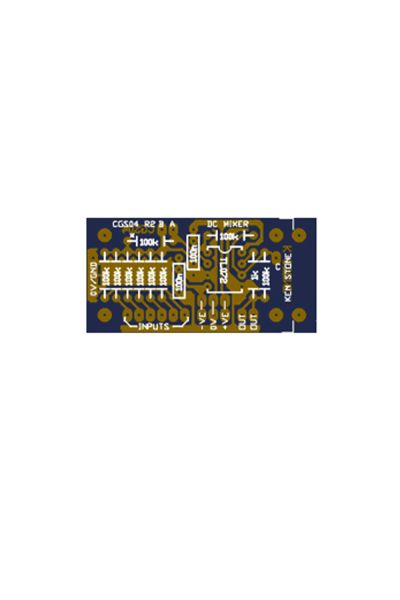CGS04 - DC Mixer | Cat Girl Synth
- Home
- Promotional Categories
- CGS04 - DC Mixer | Cat Girl Synth
CGS04 - DC Mixer | Cat Girl Synth
Special Price
$5.60
Regular Price
$7.00
A simple synth-DIY circuit preserves the D.C. component of signals, at audio frequencies and below
This is a PCB only suitable for multiple formats
Availability:Out of stock
BrandCat Girl Synth (CGS)
This project arose out of a need for a small mixer that preserved the D.C. component of signals, at audio frequencies and below, specifically for the hobbyist synthesizer builder, though it's applications do not stop there. Its compact size means it can easily be included along with other circuit boards in modules that do not have enough inputs of their own, such as some VCAs or VCFs. The previous versions can be found here.
A little on how it works:

The circuit design is quite conventional, using two op-amps in a unity gain inverting configuration. The first stage mixes the signals from the six inputs. The output signal from this op-amp is inverted. The second op-amp, which could be considered a single input "mixer" simply re-inverts it.
The resistor (*) can be replace by a variable resistor of 100k if a master level control is required. As the value of this resistor reduces, the swing at the output of the op-amp also reduces. Add a 47pF across pins 1 and 2 of the TL072 if you do this (i.e. between the A and B pads).
The 1k (330 ohms on later boards) at the output simply offers some protection to the op-amp in the event of a short circuit, which happens frequently when patch cords are being used. It is inside the feedback loop, so adding load will not affect the output, so it can quite happily drive a multiple jack.
The two 100n capacitors give some power supply isolation. Power rails can be almost anything from +/- 6V to +/- 15V. Asymmetrical rail voltages will work, but the mixer will behave as if it was running on supply of +/- of the lower of the rail voltages. E.g. supply rails of +12V/-6V would cause the mixer to behave if it was running on a +/- 6V supply.
Only a single example of an adjustable input is shown on the circuit diagram. Simply repeat as needed. If the mixer is going to be used for audio, I would suggest the use of a log pot, though for control voltage use, a linear pot may prove more suitable.
Wiring pots and some extra resistors as shown in red will allow the alternative inputs to be used as "voltage processors" where the output can be varied from inverting through to non-inverting.
The value of the pot used in the processor will affect the response of the pot. The pot itself MUST be linear. Other values of pot will vary the degree of the curve. For example, a 50k will be slightly anti-log.
- 10k - Anti-log response - Greater sensitivity near center of rotation. Finer control towards ends of travel.
- 100k - Linear response.
- 1M - Log response - Finer control near center of rotation. Greater sensitivity towards ends of travel.
| Brand | Cat Girl Synth (CGS) |
|---|---|
| Additional Resources | BOM & More Information |



